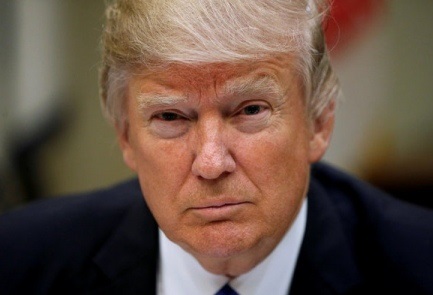U.S. President Donald Trump expected to set broad strategic objectives and leave commanders, diplomats and officials to implement policy • Proposal presented to Trump aims to step up pressure on Tehran to curb its missile program, stop support of terror.
Reuters and Israel Hayom Staff

U.S. President Donald Trump is weighing a strategy that could allow for a more aggressive U.S. response to Iran’s forces, its Shiite Muslim proxies in Iraq and Syria, and its support for militant groups, according to six current and former U.S. officials.
The proposal was prepared by U.S. Defense Secretary James Mattis, Secretary of State Rex Tillerson, national security adviser H.R. McMaster and other top officials, and presented to Trump at a National Security Council meeting on Friday, the sources said.
It could be agreed and made public before the end of September, two of the sources said. All of the sources are familiar with the draft and requested anonymity because Trump has yet to act on it.
In contrast to detailed instructions handed down by some of his predecessors, including former President Barack Obama, Trump is expected to set broad strategic objectives and goals for U.S. policy, but leave U.S. military commanders, diplomats and other U.S. officials to implement the plan, said a senior administration official.
“Whatever we end up with, we want to implement with allies to the greatest extent possible,” the official added.
The White House declined to comment.
The plan is intended to increase the pressure on Tehran to curb its ballistic missile programs and discontinue its support for terrorists, several sources said.
“I would call it a broad strategy for the range of Iranian malign activities: financial materials, support for terror, destabilization in the region, especially Syria, Iraq and Yemen,” said another senior administration official.
The proposal also targets cyber espionage and other activities and potentially nuclear proliferation, the official said.
The administration is still debating a new stance on a 2015 agreement, sealed by Obama, to curb Iran’s nuclear weapons program. The draft urges consideration of tougher economic sanctions if Iran violates the 2015 agreement.
The proposal includes more aggressive U.S. interceptions of Iranian arms shipments such as those to Houthi rebels in Yemen and Palestinian terrorist groups in Gaza and Egypt’s Sinai, a current official sad and a knowledgeable former U.S. official concurred.
The plan also recommends the U.S. react more aggressively in Bahrain, whose Sunni Muslim monarchy has been suppressing majority Shiites, who are demanding reforms, the sources said.
In addition, U.S. naval forces could react more forcefully when harassed by armed speed boats operated by the Islamic Revolutionary Guard Corps, Iran’s paramilitary and espionage contingent, three of the sources said.
U.S. ships have fired flares and warning shots to drive off IRGC boats that made what were viewed as threatening approaches after refusing to heed radio warnings in the passageway for 35% of the world’s seaborne petroleum exports.
Currently, U.S. commanders are permitted to open fire only when they think their vessels and the lives of their crews are endangered. The sources offered no details of the proposed changes in the rules, which are classified.
Islamic State First
The plan does not include an escalation of U.S. military activity in Syria and Iraq. According to four of the sources, Trump’s national security aides argued that a more muscular military response to Iranian proxies in Syria and Iraq would complicate the U.S.-led fight against Islamic State, which the aides believe should remain the top priority.
Mattis and McMaster, as well as the heads of the U.S. Central Command and U.S. Special Forces Command, have opposed allowing U.S. commanders in Syria and Iraq to react more forcefully to provocations by the IRGC, Hezbollah and other Iranian-backed Shiite militias, the four sources said.
The advisers are concerned that more permissive rules of engagement would divert U.S. forces from defeating the remnants of Islamic State, they said.
Moreover, looser rules could embroil the U.S. in a conflict with Iran while U.S. forces remain overstretched, and Trump has authorized a small troop increase for Afghanistan, said one senior administration official.A former U.S. official said Hezbollah and Iranian-backed Shiite militias in Iraq have been “very helpful” in recapturing vast swaths of the caliphate that Islamic State declared in Syria and Iraq in 2014.
U.S. troops supporting Kurdish and Sunni Arab fighters battling Islamic State in Syria have been wrestling with how to respond to hostile actions by Iranian-backed forces.
In some of the most notable cases, U.S. aircraft shot down two Iranian-made drones in June. Both were justified as defensive acts narrowly tailored to halt an imminent threat on the ground.
Trump’s opposition to the 2015 Iran nuclear deal, known as the Joint Comprehensive Plan of Action, poses a dilemma for policymakers. Most of his national security aides favor remaining in the pact, despite their reservations about Iran’s adherence to the agreement, said U.S. officials involved in the discussions.
“The main issue for us was to get the president not to discard the JCPOA. But he had very strong feelings, backed by [U.S. Ambassador to the United Nations] Nikki Haley, that they should be more aggressive with Iran,” one of the two U.S. officials said. “Almost all the strategies presented to him were ones that tried to preserve the JCPOA but lean forward on these other [issues].”



Leave a Reply
You must be logged in to post a comment.